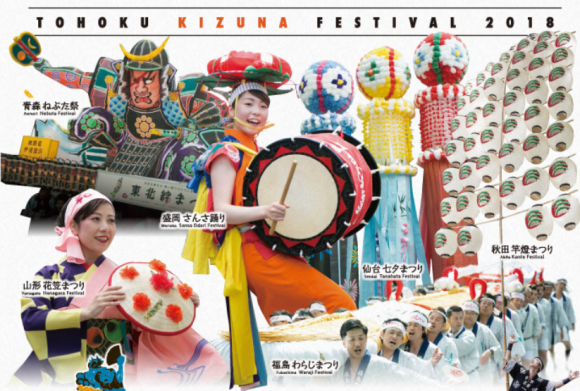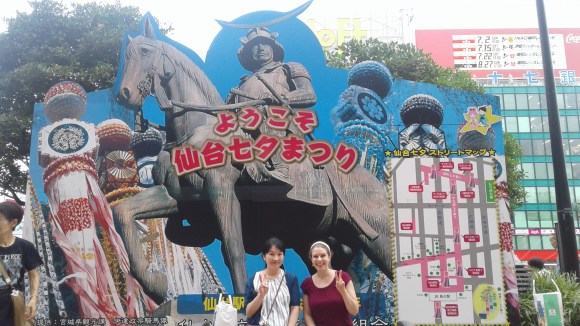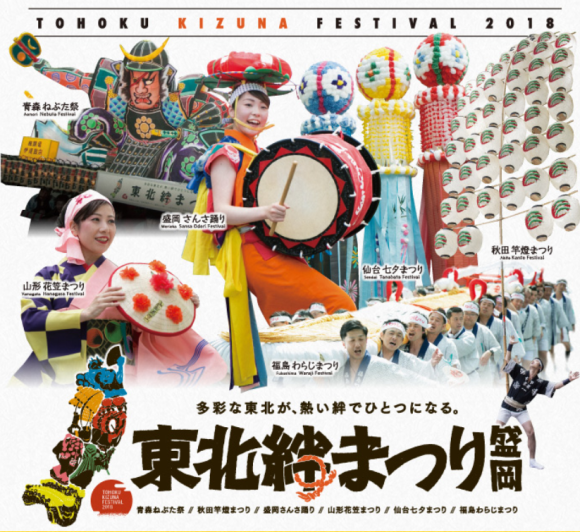
This “Festival of Tohoku Bonds” continues to pay homage to six of northern Japan’s most important annual festivals all at one time and one place.
The six northeastern prefectures that make up Japan’s main island of Honshu are an often overlooked choice for travel despite boasting some of the most pristine natural scenery and diverse cultural traditions in the entire country. The region did come into international focus under tragic circumstances in 2011, when one of the strongest earthquakes ever recorded struck off the east coast of Miyagi Prefecture and the resulting tsunami also created a nuclear disaster in neighboring Fukushima Prefecture. The people of Tohoku subsequently astounded the world with their undying spirit in spite of unbelievable destruction and loss throughout their home region.
One of the earliest responses of the Tohoku people to join together, lift each other’s spirits, and show support for recovery came in the form of the Tohoku Rokkonsai (“Tohoku Six Souls Festival”), which was first held in Sendai (Miyagi Prefecture) a mere four months following the disasters. This mega-festival showcased six of the major summer festivals celebrated annually throughout the region–Aomori’s Nebuta Matsuri, Akita’s Kanto Matsuri, Iwate’s Sansa Odori, Yamagata’s Hanagasa Matsuri, Miyagi’s Sendai Tanabata Matsuri, and Fukushima’s Waraji Matsuri–while rotating the sponsoring city each year until all six capital cities in Tohoku had played host.
▼ A welcome sign for the Sendai Tanabata Festival just outside of Sendai Station in August 2017

When the Tohoku Rokkonsai made its final stop in Aomori City in 2016, people realized they weren’t quite ready to let go of such an important tradition just yet. Thus, a spiritual successor was born: the Tohoku Kizuna Festival.
Kizuna means “bonds” in Japanese, a concept which reflects the festival’s mission of strengthening the bonds between people, aiding in continued reconstruction efforts, and demonstrating gratitude for all the support shown to Tohoku over the past seven years. The inaugural event was held in Sendai last year, and this year it’s Morioka (Iwate Prefecture)’s turn, an order which mirrors the original trajectory of the Tohoku Rokkonsai.
▼ This year’s festival logo. The illustration on the right side cleverly condenses the six festivals’ most important cultural artifacts into a map of the Tohoku region.
The 2018 festival will be held this coming weekend, June 2-3, centering on the Morioka Castle Site Park (also known as Iwate Park) at the following times:
Saturday, June 2: 10 am-7 pm (parade from 1:30-4 pm)
Sunday, June 3: 10 am-5 pm (parade from 12:30-3 pm)
As the centerpiece of the entire festival, the parade will commence in front of the Morioka City Hall and advance down the main road. This procession will highlight snippets of all six of the individual festivals, from the giant floats of Nebuta Matsuri to the synchronized dancing drummers of the host city’s Sansa Odori, in an essentially six-for-one amazing deal. For a refresher on the meaning and symbolism of the six individual festivals, please refer to this earlier piece.
Event organizers predict a total of 300,000 people to visit the festival over two days. Morioka is about two hours and ten minutes from Tokyo via bullet train, so it’s even possible to plan a day trip if you’re looking for something to do this weekend outside of the big city. The Tohoku Kizuna Festival is definitely one of the best ways to get a taste of local Japanese culture not able to be experienced in the capital region and to show your support for an amazingly strong base community of people.
Source: Tohoku Kizuna Matsuri (Japanese, English)
Featured image: Tohoku Kizuna Matsuri (edited by SoraNews24)
Insert images (unless noted): Tohoku Kizuna Matsuri



 Tohoku Rokkonsai to showcase northern Japan’s six biggest summer festivals all in one place
Tohoku Rokkonsai to showcase northern Japan’s six biggest summer festivals all in one place Latest design for gorgeous stylized Japanese Coca-Cola cans spotlights Tohoku festivals
Latest design for gorgeous stylized Japanese Coca-Cola cans spotlights Tohoku festivals Nearly 290,000 people still living in shelters two and a half years after the Tohoku disaster
Nearly 290,000 people still living in shelters two and a half years after the Tohoku disaster Hot springs website reveals the most popular user-picked onsen in all of northern Japan
Hot springs website reveals the most popular user-picked onsen in all of northern Japan Eva tie-wearing Japanese minister resigns after saying “it’s a good thing the tsunami hit Tohoku”
Eva tie-wearing Japanese minister resigns after saying “it’s a good thing the tsunami hit Tohoku” Lacquerware supplier to emperor of Japan and Pokémon team up for new tableware
Lacquerware supplier to emperor of Japan and Pokémon team up for new tableware Can a dirty butthole make you filthy rich in Japan? We’re starting a New Year’s lottery experiment
Can a dirty butthole make you filthy rich in Japan? We’re starting a New Year’s lottery experiment Japan may add Japanese language proficiency, lifestyle classes to permanent foreign resident requirements
Japan may add Japanese language proficiency, lifestyle classes to permanent foreign resident requirements Unusual curved escalators are the crowning jewel of this shopping mall in Osaka
Unusual curved escalators are the crowning jewel of this shopping mall in Osaka 7-Eleven Japan starts new temporary luggage storage service in over 300 branches
7-Eleven Japan starts new temporary luggage storage service in over 300 branches Japan’s 10 best Ferris wheels for beautiful views, as chosen by travelers【Survey】
Japan’s 10 best Ferris wheels for beautiful views, as chosen by travelers【Survey】 Does Japan’s “body fat-burning” bottled tea really work? Our 30-day investigation 【RocketScience】
Does Japan’s “body fat-burning” bottled tea really work? Our 30-day investigation 【RocketScience】 I had no idea you could win crane game prizes in Japan the way my friend won this Dragon Quest Slime
I had no idea you could win crane game prizes in Japan the way my friend won this Dragon Quest Slime Tokyo Station staff share their top 10 favorite ekiben
Tokyo Station staff share their top 10 favorite ekiben 10 great autumn Japan travel spots for fall colors and retro atmosphere【Survey】
10 great autumn Japan travel spots for fall colors and retro atmosphere【Survey】 Starbucks teams up with 166-year-old Kyoto doll maker for Year of the Horse decorations【Photos】
Starbucks teams up with 166-year-old Kyoto doll maker for Year of the Horse decorations【Photos】 Disillusionment at Tsukiji’s tourist-target prices led us to a great ramen restaurant in Tokyo
Disillusionment at Tsukiji’s tourist-target prices led us to a great ramen restaurant in Tokyo Tokyo’s Tsukiji sushi neighborhood asks tour groups to stay away for the rest of the month
Tokyo’s Tsukiji sushi neighborhood asks tour groups to stay away for the rest of the month Starbucks Japan releases new zodiac chilled cup drink for 2026
Starbucks Japan releases new zodiac chilled cup drink for 2026 Street Fighter Hadouken Churros to be launched and eaten in Tokyo, Okami pudding on offer too
Street Fighter Hadouken Churros to be launched and eaten in Tokyo, Okami pudding on offer too Is this the most relaxing Starbucks in Japan?
Is this the most relaxing Starbucks in Japan? Starbucks on a Shinkansen bullet train platform: 6 tips for using the automated store in Japan
Starbucks on a Shinkansen bullet train platform: 6 tips for using the automated store in Japan Large amount of supposed human organs left in Osaka marketplace
Large amount of supposed human organs left in Osaka marketplace Japan’s human washing machines will go on sale to general public, demos to be held in Tokyo
Japan’s human washing machines will go on sale to general public, demos to be held in Tokyo Japanese train company is letting fans buy its actual ticket gates for their homes
Japanese train company is letting fans buy its actual ticket gates for their homes Tokyo considering law requiring more trash cans following litter increase in heavily touristed area
Tokyo considering law requiring more trash cans following litter increase in heavily touristed area Is China’s don’t-go-to-Japan warning affecting tourist crowds in Tokyo’s Asakusa neighborhood?
Is China’s don’t-go-to-Japan warning affecting tourist crowds in Tokyo’s Asakusa neighborhood? Nintendo’s Kirby now delivering orders at Kura Sushi restaurants, but not in Japan
Nintendo’s Kirby now delivering orders at Kura Sushi restaurants, but not in Japan Tokyo event lets you travel back in time, for free, to celebrate 100 years since Showa era start
Tokyo event lets you travel back in time, for free, to celebrate 100 years since Showa era start Survey asks foreign tourists what bothered them in Japan, more than half gave same answer
Survey asks foreign tourists what bothered them in Japan, more than half gave same answer Japan’s deadliest food claims more victims, but why do people keep eating it for New Year’s?
Japan’s deadliest food claims more victims, but why do people keep eating it for New Year’s? We deeply regret going into this tunnel on our walk in the mountains of Japan
We deeply regret going into this tunnel on our walk in the mountains of Japan Studio Ghibli releases Kodama forest spirits from Princess Mononoke to light up your home
Studio Ghibli releases Kodama forest spirits from Princess Mononoke to light up your home Major Japanese hotel chain says reservations via overseas booking sites may not be valid
Major Japanese hotel chain says reservations via overseas booking sites may not be valid Put sesame oil in your coffee? Japanese maker says it’s the best way to start your day【Taste test】
Put sesame oil in your coffee? Japanese maker says it’s the best way to start your day【Taste test】 The top 10 annoying foreign tourist behaviors on trains, as chosen by Japanese people【Survey】
The top 10 annoying foreign tourist behaviors on trains, as chosen by Japanese people【Survey】 No more using real katana for tourism activities, Japan’s National Police Agency says
No more using real katana for tourism activities, Japan’s National Police Agency says Starbucks Japan reveals new sakura drinkware collection, inspired by evening cherry blossoms
Starbucks Japan reveals new sakura drinkware collection, inspired by evening cherry blossoms The top 11 Japanese summer festivals, according to travellers
The top 11 Japanese summer festivals, according to travellers Imoni-kai: A hidden, delicious cultural gem of northern Japan
Imoni-kai: A hidden, delicious cultural gem of northern Japan
Leave a Reply